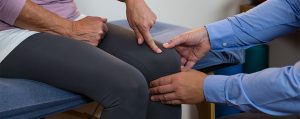Avoiding Wrist Pain and Injuries in Gymnastics
Gymnastics, the sport most watched in the Summer Olympics, engages viewers because of the extreme strength, balance, agility, accuracy, and endurance required to compete. Years of training tax the gymnast’s body to the utmost because movement refinement through repetition exposes the gymnast to many repetitive stress and traumatic injuries. While gymnasts range from the 5-year-old tumbler to the elite Olympian, a unique factor for this sport, no matter the level, is the requirement of using arms for weight bearing. Such compressive and twisting forces affect the entire arm, especially the wrist. Approximately 88% of gymnasts reportedly experience wrist pain according to one study.
Understanding Lower Extremity Injuries in Cheerleaders and Gymnasts
Cheerleading and gymnastics are incredibly demanding sports requiring strength, flexibility, and precision. Yet, they also carry a significant risk of injury, particularly in the lower extremities.
The prevalence of lower extremity injuries in cheerleading and gymnastics worldwide has increased significantly over the last decade as both sports have evolved1,2. One study, including 6-to-17-year-old gymnasts, found that the lower extremity was the most affected site of injury (60.5%), with the ankle/foot and knee joints accounting for 49% and 27% of injuries, respectively. This study also found that 10-to-12-year-olds and 13-to-17-year-olds were at greater risk for lower extremity injury due to increased growth rates compared to 6-to-9-year-olds2.
Upper Extremity Strengthening for Gymnasts
Gymnasts require significant strength, flexibility, and stability to compete in their events, whether they’re at the amateur or Olympic level. During their events, gymnasts place 2-4 times their body weight through their upper extremities (shoulder, elbow, wrist, and hand). Upper extremity injuries are common, especially in younger athletes. There is a common misconception that pain is part of the sport, but the truth is you don’t have to compete with pain. Let’s look closer at five of the most common upper extremity injuries in gymnasts and exercises that can help improve strength and reduce the potential risk of these common injuries.
How To Stick the Landing: Landing Mechanics Training for Gymnasts
The Olympic Games have a special way of bringing increased interest, awareness, and excitement to the sport of artistic gymnastics. With Simone Biles’ recorded floor tumbling pass height at the summer 2024 Paris Olympic Games achieving over 12 feet, it is imperative that she and gymnasts of all levels land safely. There are approximately 4.57 million artistic gymnasts in the United States1. As gymnasts progress through the sport, the difficulty of the skills increases, and the skills become more dangerous. Gymnastics has one of the highest rates of injury in any girl’s adolescent sport2. One recent study reported that 91.4% of elite gymnasts sustained at least one injury per season3. Another study reported that approximately 70% of gymnastics injuries occur during landing tasks4.
Hip Impingement In Gymnasts
Gymnasts require a lot of hip mobility to perform their amazing skills. These advanced and dynamic skills can lead to pain in the hip joint that is more than just muscle soreness. Both male and female gymnasts can suffer from hip pain. One common hip condition is hip impingement, and we will discuss what that is as well as important details for gymnasts with hip pain.
Treating A Broken Back In Tumbling Athletes
Tumbling activities put a lot of force through the spine and can put more stress on the lower back in certain circumstances. Tumbling athletes occasionally have an injury and report a “broken back.” What does this really mean? For the purpose of this blog, we will focus on the lower back or lumbar region only. We’ll dive into what a broken back is, and how recovery may look with a goal of returning to tumbling sports such as cheerleading or gymnastics.
What To Watch: Gymnastics Summer 2024 Olympics
The summer Olympics are fast approaching. Gymnastics for the Olympics includes artistic gymnastics, rhythmic gymnastics, and trampoline events. If you plan to tune in to any Gymnastics coverage from Paris, here is some information on how gymnastics is scored and who to look for on Team USA.
Foot Injuries in Rhythmic Gymnasts
Rhythmic gymnastics is a sport in which gymnasts perform on a floor with an apparatus: either a hoop, ball, rope, ribbon, or club. The sport combines dance and gymnastics and requires strong, flexible, coordinated athletes. Due to the nature of the sport and the repetition during practice and performing, the most common area of injury for rhythmic gymnasts is the foot.
